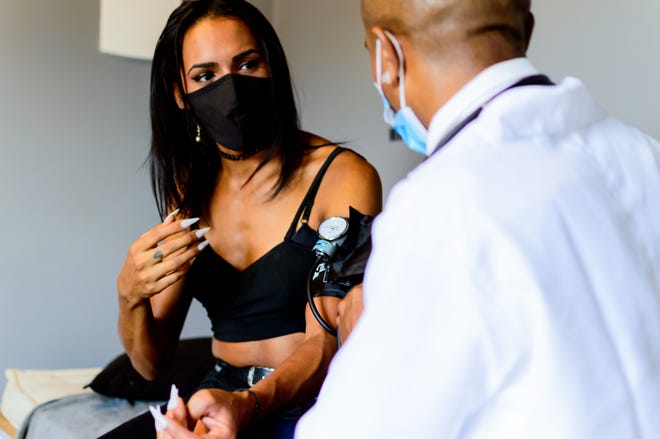“Are you sexually active?” a doctor asks. “Yes,” a female patient responds.
“Do you take birth control?” they ask. “No,” she answers.
“Do you use condoms?” “No…”
“Are you trying to have a baby?” “No.”
“So then how are you preventing pregnancy?” “…I’m gay.”
This is the premise of dozens of TikTok videos discussing the awkwardness that comes from doctors appointments when patients’ sexuality is assumed.
User @haleyfaulkner posted a version of this interaction, garnering more than 900,000 likes and 6.3 million views, along with many echoing her experience in comments.
Dr. David Jaspan, chair of OB/GYN for Einstein Healthcare Network in Philadelphia, says, unfortunately, this situation is not unusual.
“It’s very common, because that’s classic training,” he explains. “It just gets down to this like ‘traditional’ medical line of questioning which is old, antiquated and now not appropriate for (everybody).”
Other members of the LGBTQ community have also spoken out on social media about uncomfortable encounters stemming from assumptions about sexual orientation and gender identity to the gendered language in hospitals.
Experts say the lack of LGBTQ-inclusive care is caused by a variety of factors, but the need to improve the system is vital in preventing potential detrimental outcomes for people in this community.

Why is this still an issue?
Stigma is one piece that contributes to a lack of LGBTQ inclusivity.
Dr. Leonid Poretsky, an endocrinologist who is the director of the Gerald J. Friedman Transgender Program at Lenox Hill Hospital in New York, says he and his peers are still trying to “de-pathologize” transgender identities.
“There’s nothing wrong with being transgender; it’s not a disease,” he says. There is still progress to be made, he says.
For insurance, medical coding systems can make providing care a challenge.
Jaspan ran into this issue when treating a transgender male who wanted a hysterectomy, the first patient of Einstein’s Pride Program.
“(We) said to this person, we can write down abnormal uterine bleeding and pelvic pain and get it approved (by insurance), or we could do what we want and do what’s right and say it’s for gender affirmation. We’ll get rejected, and we’ll fight it.”
And that’s exactly what happened. The situation turned into a lawsuit, which ended in a victory: all trans care in the state of Pennsylvania being covered by Medicaid.
“That changed everything because then we had an opportunity for patients to gain access to care, without having to fight about it not having to pay out of pocket, not having to do it in an inappropriate, perhaps not professional location,” he added.
Unfortunately, this isn’t the case everywhere, and stigma and discrimination can still deter LGBTQ people from seeking medical care.
- In a recent survey, one in four LGBTQ people reported experiencing discrimination, while 8% of lesbian, gay and bisexual adults and 29% of transgender adults reported that a health care provider refused to see them because of their sexual orientation or gender identity.
- A survey by the National Center for Transgender Equality found that 33% of respondents had experienced a negative interaction with a healthcare provider because of their gender identity in the year prior.
More:New research reveals ‘shocking’ rates of anti-LGBTQ discrimination

Lack of education surrounding LGBTQ identities also plays a role.
“(We need) to educate medical providers that there’s nothing peculiar or weird or strange about care of these patients. It should be mainstream care just like any other patient that walks into our office,” Poretsky says. “The problem is the training isn’t there yet. Many medical schools are beginning to institute LGBT curriculum, but it’s not really something that is present everywhere.”
This learning gap is exacerbated by how much can change in the approximately 10 years it takes to go from medical school to practicing in the community.
“Most practicing physicians today didn’t have any exposure to this kind of training and that creates another obvious barrier,” he says.
Jaspan, who finished his residency in 1999, is proof that overcoming this barrier is possible.
“‘When a woman gets her period.’ How many times do you think I’ve said that phrase? Hundreds and thousands,” he admits. “Now I have to think about that phrase, and say ‘when a person’ which doesn’t change anything. I just have to change my vocabulary… It’s recognizing that not just women have periods. It’s being able to be open minded and think differently about what we are quote-unquote normally trained to think about.”
The harm in leaving things as-is
Poretsky says many LGBTQ patients have been “disillusioned” by the medical field.
“One of the worst potential outcomes of a situation that the patient will not go and receive care anymore,” Poretsky says. “One of the worst things we can do is make them so uncomfortable that they will just not come back to us.
Einstein’s Pride Program was born 7.5 years ago out of the need for better care among their own staff, Jaspan explained.
“One of our interns at the time was taking care of a patient with cervical cancer, and the intern came into my office and she said how we care for lesbian women is not acceptable,” he recounted.
After asking why, the intern responded, “Because I’m taking care of a patient who’s an employee here and has cervical cancer. And the reason she didn’t get her regular screening was because she thought she’d be marginalized.”
Jaspan has seen how critical it is that patients feel at ease. He recalled an instance when he was able to begin a dialogue about hormones after noticing a patient listed a preferred name.
“Because I was able to just outwardly ask, you could immediately see their body language, their shoulders relaxed, their position in the chair changed.”
If a patient doesn’t feel comfortable enough to give information on their history, a misdiagnosis can occur, Poretsky adds.
“When we’re trying to establish diagnosis, history becomes the most important part of information that we can get from the patient. So obviously, if the patient is not feeling comfortable with the physician or nurse…the history we get may not be complete or accurate.”
And if physicians lack understanding of certain identities, like a trans woman who still needs prostate cancer screenings, vital steps could be missed.
“So a physician not prepared to deal with this population may be missing important health care issues and screenings,” Poretsky says.
Ways healthcare providers can be more mindful of LGBTQ patients
In addition to not assuming heterosexual relationships or cisgender identities, Jaspan says there are other ways to make sure LGBTQ patients feel more comfortable.
Gendered language, for example, is often prevalent in hospitals such as “mom and baby units.”
“That seems to be not gender neutral, so we’re changing the name to the perinatal unit. It’s still the same thing!”
“We’re trying desperately to be inclusive in everything that we do,” he says, adding that their office also includes signage like rainbow flags and equality stickers.
“It doesn’t fix everything, but it at least openly shows to people without words being spoken that at least that office recognizes LGBT patients,” he says.
Being mindful and “highly sensitive” to a patient’s experience is also key.
For a trans male patient who still needs gynecological exams, it’s “probably the worst day for that person,” he explains.
Poretsky notes that some offices try to ameliorate discomfort by providing specific days or times for trans patients so they can feel less singled-out in waiting rooms.
Family planning as well as fertility issues and preservation can also be a sensitive area for patients.
“Some trans men may be able to get pregnant,” Poretsky explains. “For a man to get pregnant, obviously is kind of a difficult concept (for some), but it happens. It’s not that uncommon anymore.”
Jaspan says caring for LGBTQ patients is “much, much more than the medicine or the surgery. It’s really about advocacy and the medicine and the surgery. And being an ally for patients.”
That means taking accountability too.
“Are we perfect? Absolutely not. Do we make mistakes? We do. But I really think that when we make mistakes patients recognize it’s coming from a good place and we want to learn from our mistake,” he says. “If we misgender them or use the wrong pronoun, we are immediately by our body language and our words, recognizing it and allowing the patient to correct us. We’re not reacting in a negative way to the correction.”
What’s the way forward?
LGBTQ-focused programs are leading the way in terms of training for inclusive care, but Jaspan says it goes back to medical school education as well.
From pharmacy schools to nurses, nurse practitioners and midwives, he says it’s important for everyone in health care to be brought up-to-speed.
Poretsky also hopes to see more diversity in medical staffs.
“It would be nice if we could have more transgender providers or LGBT providers among the physicians and everybody else who works with patients,” he says, as it helps to make patients of the same experience feel comfortable.
Until these things happen, Jaspan hopes health institutions can, at least, start to better recognize the LGBTQ community.
“I would hope that every healthcare organization wants to provide care for the communities that they serve. And they should hopefully recognize that their communities are made up of more than just men and women,” he says.
More:What people are getting wrong about asexuality (a lot)
More:LGBTQ and straight, cisgender dating are vastly different. Or are they?









